Every year I make an annual pilgrimage to the Consumer Electronics Show in Las Vegas.
|Every year I make an annual pilgrimage to the Consumer Electronics Show in Las Vegas.It was hard work but, a couple of years ago, I could just about cover the entire show in a single day; if I moved fast.Last year, there was just too much to see, so I vowed that I’d spend two days at the show this year. I stuck to that promise! This year, I attended for two days. The problem? The show has gotten bigger still. I raced around the exhibition floors for two days (with just a brief pause for a short speaking engagement), and still did not get chance to see all I wanted. This show is big (2.47 million square feet). I did not get chance to watch any of the other speakers.It’s also a busy show. I believe I heard that the attendance this year was around 170,000 people.| |
|
Last year, there was just too much to see, so I vowed that I’d spend two days at the show this year. I stuck to that promise! This year, I attended for two days. The problem? The show has gotten bigger still. I raced around the exhibition floors for two days (with just a brief pause for a short speaking engagement), and still did not get chance to see all I wanted. This show is big (2.47 million square feet). I did not get chance to watch any of the other speakers.
| |I like to blog about the things I see, and give my opinions. This is not intended to be an exhaustive or definitive coverage of the show (I’ll leave that to the official press who have the luxury of longer dedicated coverage options), but more as a sprinkling of things that popped out as I walked the halls. As noted above, I did not get chance to cover the whole show. If your company had a great product, and I missed it, I’m sorry. Maybe next year …For refernce, here are my notes from previous years:Consumer Electronics Show 2015|
|I like to blog about the things I see, and give my opinions. This is not intended to be an exhaustive or definitive coverage of the show (I’ll leave that to the official press who have the luxury of longer dedicated coverage options), but more as a sprinkling of things that popped out as I walked the halls. As noted above, I did not get chance to cover the whole show. If your company had a great product, and I missed it, I’m sorry. Maybe next year …For refernce, here are my notes from previous years:Consumer Electronics Show 2015|
For refernce, here are my notes from previous years:
To me, this year, CES could be divided into three sections: |1| The first is the traditional display of TVs, cellphones, laptops, and cameras that we see every year from the big box guys like LG, Sony, Samsung et al.. I love seeing their new product lines. Every year there are better quality devices and I love to see them. The booths are, typically, well set up, the devices tuned and tweaked, and they are being put through their paces showing fabulous content. The demos are loud, dynamic, and impressive.| |2|The second section is the auto section. Unless you’ve been living under a rock you’ll know that cars are turning into rolling super computing platforms. I’m not just talking about electric propulsion cars (of which there were certainly many on display), but traditional internal combustion engine cars are getting driving assistance, and even self-driving autonomy capabilities. The traditional dashboards are being replaced by complex panels. The next generation cars are going to have more processing power than a wheel barrow full of Xboxes.| |3|The third section of the show, and the one I wished I had more chance to explore fully is the innovation section. There were literally hundreds and hundreds of little booths from fledgling start-ups, and small businesses ahowing off their novel gadgets. With 3D printing, rapid prototype tools/services, small micro-controllers, and access to cheap cloud computing, it’s become more possible than ever to get a prototype product up and to the first stage almost, proverbially, from your garage at home. Some of their inventions where, IMHO, a little dubious in their feasability, but you can’t fault the founders’ passion and enthusiam. It’s a great time to be an entrepreneur!|
If I had to summarize the show in just a few words these would be:
-
Drones
-
VR
-
Cars
-
Health
-
Internet of Things (many of them pointless)
-
Maturity of 3D printing
-
(Oh, and Quantum Dot TV’s, and the other HDR displays, they were pretty cool)
 |
Flying drones were everywhere. You’d hear the displays first; that characteristic buzz. Then you’d look ahead and see the torpedo safety netting around a booth from floor to ceiling indicating there was a demo area. There is something about drones that is just so compelling to watch. The way they hover; not quite rock steady so that they are appear artifical. The imperceptable way they micro-adjust makes them earily alive in appearance. They are alien-like in the hybrid way they move. |
I’ve not yet purchased a drone, but this year might be the year I do.

 |
This is the breakout year for VR. OK, I’m biased (and yes Oculus Rift has gone on pre-sales). Dozens of booths were demoing products built with DK2.I’m really bullish about VR and AR. I really think this will be the next major computing platform/form-factor: Desktop, Laptop, Mobile, Tablet and now headset. (I think that volume of headsets sales will rapidly overtake smartwatch sales).If I were in the game console business, I’d be worried. Once you’ve played an action game with a VR headseat on, you’re not going to want to go back to the playing on a regular screen. |
I’m really bullish about VR and AR. I really think this will be the next major computing platform/form-factor: Desktop, Laptop, Mobile, Tablet and now headset. (I think that volume of headsets sales will rapidly overtake smartwatch sales).
There were over 100 automotive tech makers at CES 2016. The auto industry is going to change more in the next half dozen years than it has in the last half a century. It’s nice to see all these things at the Consumer Electronics show, but I think there’s critical mass now for a dedicated show related to these technologies. As more and more autonomy gets baked into vehicles, they are getting closer to being digital companions every day.
| |The auto industry is going to change more in the next half dozen years than it has in the last half a century.|
|The auto industry is going to change more in the next half dozen years than it has in the last half a century.|
Of the large automakers at the show, I passed booths hosted by: Audi, BMW, Chrysler, GM, Ford, Hyundai, Toyota, and Volkswagen.
| |All the cars were sporting fancy new dashboards and dripping with technology, and the thing noticable to me was the complete lack of any presence of Microsoft anywhere in this arena.And, I’m not just talking about the lack of Microsoft’s presence running the back end of these cars (Ford has quietly dropped Microsoft as the vendor from it’s much advertised Ford Sync and MyFord Touch products, which used to run on Windows Embedded, and instead the latest generation Ford Sync 3 runs on Blackberry’s QNX unix platform).What I was referring to was the bluetooth pairing of your phone when you enter the car, and getting access to your apps (maps, contacts, music, digital assistants …) through the cars controls.All the cars I was able to visit had both Apple CarPlay and Android Auto baked in … and no option for Windows Phone. It’s currently a two horse race.*|
|All the cars were sporting fancy new dashboards and dripping with technology, and the thing noticable to me was the complete lack of any presence of Microsoft anywhere in this arena.And, I’m not just talking about the lack of Microsoft’s presence running the back end of these cars (Ford has quietly dropped Microsoft as the vendor from it’s much advertised Ford Sync and MyFord Touch products, which used to run on Windows Embedded, and instead the latest generation Ford Sync 3 runs on Blackberry’s QNX unix platform).What I was referring to was the bluetooth pairing of your phone when you enter the car, and getting access to your apps (maps, contacts, music, digital assistants …) through the cars controls.All the cars I was able to visit had both Apple CarPlay and Android Auto baked in … and no option for Windows Phone. It’s currently a two horse race.*|
And, I’m not just talking about the lack of Microsoft’s presence running the back end of these cars (Ford has quietly dropped Microsoft as the vendor from it’s much advertised Ford Sync and MyFord Touch products, which used to run on Windows Embedded, and instead the latest generation Ford Sync 3 runs on Blackberry’s QNX unix platform).
All the cars I was able to visit had both Apple CarPlay and Android Auto baked in … and no option for Windows Phone. It’s currently a two horse race.*
Considering how much time people spend in cars, this a huge hurdle and barrier for Windows. Also, if cars do become more and more autonomous, then connectivity to your phone is going to be become increasingly more important as a car will become an extension of the office and allow you to do some percentage of work like tasks during your commute (or enjoyably sending email, texts, or catch up on your social networks). Wake up Redmond, the cars are leaving the garage …
*If it’s going to turn into a three horse race, then Amazon might be that third horse. Already Ford have announced integration between Amazon-Echo and their cars, so you will be able to talk to the smart assistant to check on fuel or charge level of your vehicle from the comfort of your home (and the other way around; you will be able to control parts of your smart home when driving in your car).
| |There were more than 500 exhibitors showing some product related to digital health. Fitness trackers, blood pressure sensors, activity monitors, sleep sensors … I got fatigued just looking at them all. They’ve almost become commodity items; there’s only a certain number of bodily parameters to track and pretty much all the bands are tracking all of these already, and offering uploads into the cloud for tracking, monitoring, and trend analysis. The differentiations seem to be in form factor and fashion (not functionality).|
|There were more than 500 exhibitors showing some product related to digital health. Fitness trackers, blood pressure sensors, activity monitors, sleep sensors … I got fatigued just looking at them all. They’ve almost become commodity items; there’s only a certain number of bodily parameters to track and pretty much all the bands are tracking all of these already, and offering uploads into the cloud for tracking, monitoring, and trend analysis. The differentiations seem to be in form factor and fashion (not functionality).|
According to the CTA, almost 1 in 10 household owns a wearable fitness tracker, and staggeringly, this has doubled from last year. Gamification of life is a thing. I don’t own a fitness tracker, but out of interest, I wish I would have worn one during my time in Vegas. I’d be curious to know how many miles I’ve walked over the last two days at the show!
| |I used to joke that IoT was the acronym for “Internet of Toilets” (instead of “Internet of Things”). Just because you can connect something to the internet does not mean that you should. Yes, having interfaces to some things adds a huge amount of value, but for others, it’s a little pointless.Do I really need an internet connected kettle to boil water? If I go into the kitchen to make a cup of tea and turn on the kettle, I’m already right there! Does it really need to page me when it’s boiled? Does it add value to my life to be able to set it to generate hot water that is not exactly 100°C? How would my life change if I was able to graph a chart of the number of times I used the kettle over the last year, and the modal time of the day I boiled water? And how useful is it to be able to turn it on remotely if there is no water in it?|
|I used to joke that IoT was the acronym for “Internet of Toilets” (instead of “Internet of Things”). Just because you can connect something to the internet does not mean that you should. Yes, having interfaces to some things adds a huge amount of value, but for others, it’s a little pointless.Do I really need an internet connected kettle to boil water? If I go into the kitchen to make a cup of tea and turn on the kettle, I’m already right there! Does it really need to page me when it’s boiled? Does it add value to my life to be able to set it to generate hot water that is not exactly 100°C? How would my life change if I was able to graph a chart of the number of times I used the kettle over the last year, and the modal time of the day I boiled water? And how useful is it to be able to turn it on remotely if there is no water in it?|
Do I really need an internet connected kettle to boil water? If I go into the kitchen to make a cup of tea and turn on the kettle, I’m already right there! Does it really need to page me when it’s boiled? Does it add value to my life to be able to set it to generate hot water that is not exactly 100°C? How would my life change if I was able to graph a chart of the number of times I used the kettle over the last year, and the modal time of the day I boiled water? And how useful is it to be able to turn it on remotely if there is no water in it?
The award winning toilet seat above seems to have plenty of sensors built in. I didn’t read the specs, but those contacts on the seat look like the ones I’ve seen on bathroom scales that pass current to estimate your percentage of body fat. (OK, for anyone who has one of these seats, what is the refresh rate for the measurements? Can you see changes to your body as you use the toilet?)
I visited the main exhibition halls first (those for the big box guys and the autos). Here are my notes in the rough chronoligcal order that I visited them (for no other arbitrary reason):
| |Every year, LG puts on a fabulous display using their latest top-of-the-line TVs. This year was no exception. This year they were showing off their SUHD HDR displays. These displays are staggeringly beautiful. The blacks in the images are deafeningly black; the colours are blisteringly intense, the pixels are too small to comprehend, and the refresh rates super fluid.In the opening area of the booth they tessellated (too many to count) screens into a choreographed mosaic. My small pictures can’t do the displays justice. (The demo loop wasn’t quite as nice as last year though).|
|Every year, LG puts on a fabulous display using their latest top-of-the-line TVs. This year was no exception. This year they were showing off their SUHD HDR displays. These displays are staggeringly beautiful. The blacks in the images are deafeningly black; the colours are blisteringly intense, the pixels are too small to comprehend, and the refresh rates super fluid.In the opening area of the booth they tessellated (too many to count) screens into a choreographed mosaic. My small pictures can’t do the displays justice. (The demo loop wasn’t quite as nice as last year though).|
In the opening area of the booth they tessellated (too many to count) screens into a choreographed mosaic. My small pictures can’t do the displays justice. (The demo loop wasn’t quite as nice as last year though).
As I commented last year, it’s no longer about who has the ‘biggest’ TV (though a couple of booths did not get the memo), as all the major players have devices in all the sizes your home could possibly handle. It’s all about image quality. The capabilities of these devices are so good that we’ll have to wait for streaming services and content delivery options/players to catch up.
|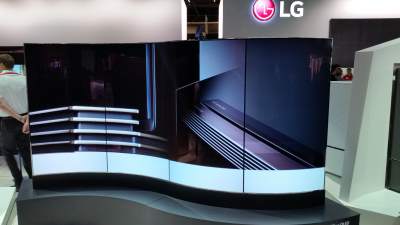 |It’s a bit of a niche, so not stricly a product a consumer would have in their homes, but LG were showing a couple of curved screens, butted together to make a video display wall. Yes, we’ve all seen curved display screens by now, but these were interesting to me as I walk past for two reasons. The first reason was they were curved in portrait format, rather then landscape format, and second reason was that two of them had convex curves instead of concave.I doubt we’ll ever see portrait convex curve 80” SUHD OLED screens in Costco!|
|It’s a bit of a niche, so not stricly a product a consumer would have in their homes, but LG were showing a couple of curved screens, butted together to make a video display wall. Yes, we’ve all seen curved display screens by now, but these were interesting to me as I walk past for two reasons. The first reason was they were curved in portrait format, rather then landscape format, and second reason was that two of them had convex curves instead of concave.I doubt we’ll ever see portrait convex curve 80” SUHD OLED screens in Costco!|
I doubt we’ll ever see portrait convex curve 80” SUHD OLED screens in Costco!
|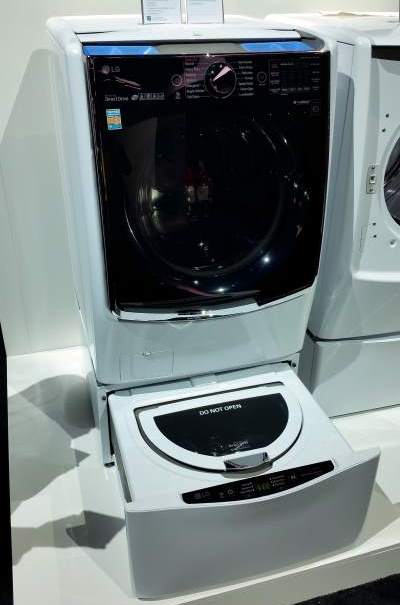 |LG were also showing off other devices. Here’s a washing machine with two washing comparments. The lower compartment has a smaller capacity and lives in, what is usually, the storage drawer underneath.Now it’s possible to wash two loads at the same time (one big, one small), without fear of colours running, and at different temperatures.Or, if you have just a small load, you can save water and electricity by just running the smaller one.(In light of how everything is now IoT and connected, it can probably page you over WiFi when your socks are washed, and I bet there’s probably an app that allows you to monitor and change the temperature of the water, and the spin-speed dynamically in incrementns of 10 RPM. They’ll probably publish an API that allows you to upload customized wash profiles for each of your clothes)**This is all speculation, and a little sarcasm. I have no idea of the capabilities of the washer; I never stopped to ask.If I were designing a smart washer, I’d have it detect if a smartphone was inside it before adding water (I have a non-zero number of friends who have put their iPhones through a wash cycle. One of them has done it more than once). I think this is probably a good use for an RFID beacon too. If I put an RFID tag in my wallet then the washing machine should be able to detect if my wallet is in the load too!(If any manufacturers implement these features, I’ll be happy to accept a small royalty …)|
|LG were also showing off other devices. Here’s a washing machine with two washing comparments. The lower compartment has a smaller capacity and lives in, what is usually, the storage drawer underneath.Now it’s possible to wash two loads at the same time (one big, one small), without fear of colours running, and at different temperatures.Or, if you have just a small load, you can save water and electricity by just running the smaller one.(In light of how everything is now IoT and connected, it can probably page you over WiFi when your socks are washed, and I bet there’s probably an app that allows you to monitor and change the temperature of the water, and the spin-speed dynamically in incrementns of 10 RPM. They’ll probably publish an API that allows you to upload customized wash profiles for each of your clothes)**This is all speculation, and a little sarcasm. I have no idea of the capabilities of the washer; I never stopped to ask.If I were designing a smart washer, I’d have it detect if a smartphone was inside it before adding water (I have a non-zero number of friends who have put their iPhones through a wash cycle. One of them has done it more than once). I think this is probably a good use for an RFID beacon too. If I put an RFID tag in my wallet then the washing machine should be able to detect if my wallet is in the load too!(If any manufacturers implement these features, I’ll be happy to accept a small royalty …)|
Now it’s possible to wash two loads at the same time (one big, one small), without fear of colours running, and at different temperatures.
(In light of how everything is now IoT and connected, it can probably page you over WiFi when your socks are washed, and I bet there’s probably an app that allows you to monitor and change the temperature of the water, and the spin-speed dynamically in incrementns of 10 RPM. They’ll probably publish an API that allows you to upload customized wash profiles for each of your clothes)*
If I were designing a smart washer, I’d have it detect if a smartphone was inside it before adding water (I have a non-zero number of friends who have put their iPhones through a wash cycle. One of them has done it more than once). I think this is probably a good use for an RFID beacon too. If I put an RFID tag in my wallet then the washing machine should be able to detect if my wallet is in the load too!
| |
| |
|Just when I thought I’d seen the last of 3D TVs, LG slipped a couple back into their booth. 3D was huge a couple of years ago; with every manufacturer demoing them, but the technology never took off with consumers, and they were hardly anywhere to be seen last year either.|Want to see what a 98” 8K TV looks like (with Chrome Frame)? Changhong can help you out with this desire. I tried to capture a person in the shot for scale. It’s a great technology demonstrator, but the average “consumer” is not going need an 98” screen.|
|
|Just when I thought I’d seen the last of 3D TVs, LG slipped a couple back into their booth. 3D was huge a couple of years ago; with every manufacturer demoing them, but the technology never took off with consumers, and they were hardly anywhere to be seen last year either.|Want to see what a 98” 8K TV looks like (with Chrome Frame)? Changhong can help you out with this desire. I tried to capture a person in the shot for scale. It’s a great technology demonstrator, but the average “consumer” is not going need an 98” screen.|
Want to see what a 98” 8K TV looks like (with Chrome Frame)? Changhong can help you out with this desire. I tried to capture a person in the shot for scale. It’s a great technology demonstrator, but the average “consumer” is not going need an 98” screen.
| |Intel were proudly showing off their RealSense™ technology (module shown on the left). This device contains a hybrid of cameras and sensors* to record a depth map along with with a high resolution picture. They had a variety of demo applications showing how it could be used to interpret gestures and capture objects in 3D.There was a line of people waiting to be scanned by the technology and turned into models that could be used in the Fallout video game.|
|Intel were proudly showing off their RealSense™ technology (module shown on the left). This device contains a hybrid of cameras and sensors* to record a depth map along with with a high resolution picture. They had a variety of demo applications showing how it could be used to interpret gestures and capture objects in 3D.There was a line of people waiting to be scanned by the technology and turned into models that could be used in the Fallout video game.|
There was a line of people waiting to be scanned by the technology and turned into models that could be used in the Fallout video game.
*A 1080p visible wavelength camera, an infra-red camera, and an infra-red laser projector.
| |
| |
|Smart watches were everywhere (in glass cases). Paradoxically, I did not see a lot of people walking around the show wearing smartwatches. I think I counted more selfiestick users than smartphone wearers.|Every fashion of smartphone cases could be seen at the show.|
|
|Smart watches were everywhere (in glass cases). Paradoxically, I did not see a lot of people walking around the show wearing smartwatches. I think I counted more selfiestick users than smartphone wearers.|Every fashion of smartphone cases could be seen at the show.|
Every fashion of smartphone cases could be seen at the show.
| |
|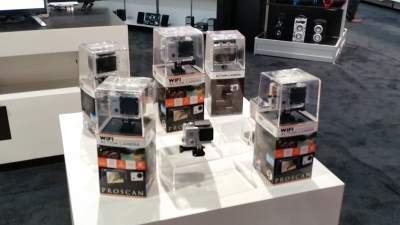 |
|GoPro had an impressive booth, with a giant (very bright) video wall showing awesome content. Very compelling to watch.|Fame, however, comes with consequences. I had to do a double-take when I walked past this booth and saw a collection of “GoPro-like” products. Even the packaging looks the same style!|
|
|GoPro had an impressive booth, with a giant (very bright) video wall showing awesome content. Very compelling to watch.|Fame, however, comes with consequences. I had to do a double-take when I walked past this booth and saw a collection of “GoPro-like” products. Even the packaging looks the same style!|
Fame, however, comes with consequences. I had to do a double-take when I walked past this booth and saw a collection of “GoPro-like” products. Even the packaging looks the same style!
Casio has entered the smart watch business with a smart outdoor watch (not shown). I’m less cynical about this than regular smart watches because if I’m wearing this device (with built in pressure sensors to measure altitude), then I’m performing a special hiking event and don’t mind charging it up the day before and that it will only have limited battery life. It would not be a device I would wear every day. It’s a pretty watch and the face plate can display graphs of your hiking progress.
|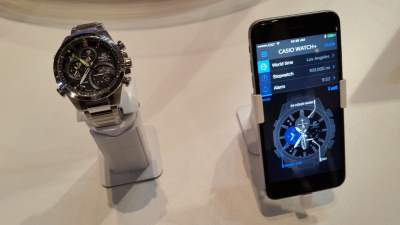 |More interesting to me, however, is the watch shown here. It’s a traditional electro-mechanical watch (very similar to one I wear every day). The entire face plate is a solar cell so that it never needs a replacement battery and will run for life as long as it gets a little sunlight every day (eat that smart watches). It syncs with atomic clocks for accuracy, has built in alarms, and works with multiple time zones.The only difference from my current watch is that this watch, using Bluetooth, can sync with a smartphone app and you can change time zones, and set alarms on your phone and beam these changes to the watch. An interface on a phone is easier to manipulate than the small dials on a watch. If I were buying a new watch today, this would be on my shortlist.|
|More interesting to me, however, is the watch shown here. It’s a traditional electro-mechanical watch (very similar to one I wear every day). The entire face plate is a solar cell so that it never needs a replacement battery and will run for life as long as it gets a little sunlight every day (eat that smart watches). It syncs with atomic clocks for accuracy, has built in alarms, and works with multiple time zones.The only difference from my current watch is that this watch, using Bluetooth, can sync with a smartphone app and you can change time zones, and set alarms on your phone and beam these changes to the watch. An interface on a phone is easier to manipulate than the small dials on a watch. If I were buying a new watch today, this would be on my shortlist.|
The only difference from my current watch is that this watch, using Bluetooth, can sync with a smartphone app and you can change time zones, and set alarms on your phone and beam these changes to the watch. An interface on a phone is easier to manipulate than the small dials on a watch. If I were buying a new watch today, this would be on my shortlist.
| |
| |
|Did I mention there were lots of cars at the show? Here is one of them. It wasn’t in the auto section of the show. It was surrounded by TVs.|Casio were also showing a 2.5D printer. This is a like a regular colour printer but the front of the paper could be contoured out to make slight relief. The samples I looked at seemed to have a depth, at maximum point, of about 1/4 inch. Certainly enough to feel and see. I’m sure this could be used to print braile, and some of the samples passed around showed printouts of anatomy; the relief did seem to help convey information. The texture of the relief was ever so slightly spongey.|
|
|Did I mention there were lots of cars at the show? Here is one of them. It wasn’t in the auto section of the show. It was surrounded by TVs.|Casio were also showing a 2.5D printer. This is a like a regular colour printer but the front of the paper could be contoured out to make slight relief. The samples I looked at seemed to have a depth, at maximum point, of about 1/4 inch. Certainly enough to feel and see. I’m sure this could be used to print braile, and some of the samples passed around showed printouts of anatomy; the relief did seem to help convey information. The texture of the relief was ever so slightly spongey.|
Casio were also showing a 2.5D printer. This is a like a regular colour printer but the front of the paper could be contoured out to make slight relief. The samples I looked at seemed to have a depth, at maximum point, of about 1/4 inch. Certainly enough to feel and see. I’m sure this could be used to print braile, and some of the samples passed around showed printouts of anatomy; the relief did seem to help convey information. The texture of the relief was ever so slightly spongey.
|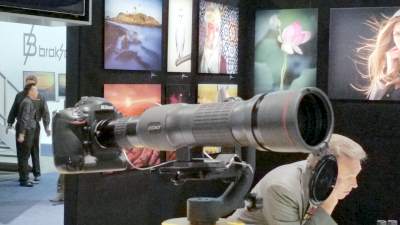 |The traditional DSLR makers were at the show in force. With the increasing sophistication and profileration of high quality cameras in smart phones, these devices are becoming more niche and pretty much limited to the professionals and only the keenest of consumers.If multi-apperature computational cameras can deliver what they promise, I wonder if we might be at the dawn of another step disruption in the photographic industry? Could there be a second “Kodak Moment” (The first being the death of traditional film with the shift to digital), when then world wakes up to find the industry has changed overnight. Kodak’s inability to pivot to digital fast enough effectively killed them.|
|The traditional DSLR makers were at the show in force. With the increasing sophistication and profileration of high quality cameras in smart phones, these devices are becoming more niche and pretty much limited to the professionals and only the keenest of consumers.If multi-apperature computational cameras can deliver what they promise, I wonder if we might be at the dawn of another step disruption in the photographic industry? Could there be a second “Kodak Moment” (The first being the death of traditional film with the shift to digital), when then world wakes up to find the industry has changed overnight. Kodak’s inability to pivot to digital fast enough effectively killed them.|
If multi-apperature computational cameras can deliver what they promise, I wonder if we might be at the dawn of another step disruption in the photographic industry? Could there be a second “Kodak Moment” (The first being the death of traditional film with the shift to digital), when then world wakes up to find the industry has changed overnight. Kodak’s inability to pivot to digital fast enough effectively killed them.
Just look at that lens above. Do you think the owner might be over compensating for something?
|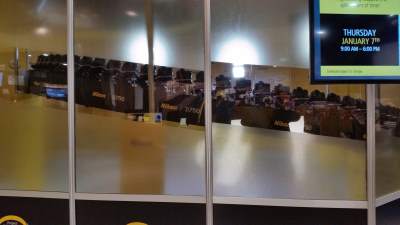 |
|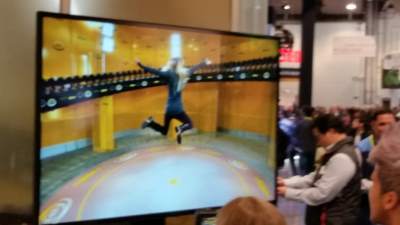 |
|Apologies for the blurred photos (ironic that I’m taking photos of very expensive cameras using my phone), but what can you do if you have 96 high end DSLR cameras? …|… simple, you mount them in a big circle, with 3.75° between each one and sychronize them, then let people jump up in the air and take pictures. Then, using stitching software, you can convert the images into those “Matrix-like” video effects where you can spin, virtually around the target.|
|
|Apologies for the blurred photos (ironic that I’m taking photos of very expensive cameras using my phone), but what can you do if you have 96 high end DSLR cameras? …|… simple, you mount them in a big circle, with 3.75° between each one and sychronize them, then let people jump up in the air and take pictures. Then, using stitching software, you can convert the images into those “Matrix-like” video effects where you can spin, virtually around the target.|
… simple, you mount them in a big circle, with 3.75° between each one and sychronize them, then let people jump up in the air and take pictures. Then, using stitching software, you can convert the images into those “Matrix-like” video effects where you can spin, virtually around the target.
| |
|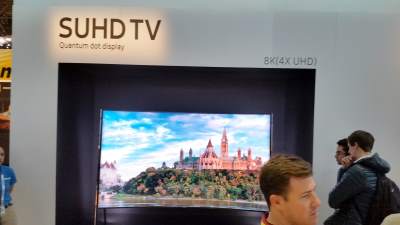 |
|Not to be a pedant, but Samsung, when you say you have the “World’s largest 170” SUHD TV”, aren’t all 170” TV’s the same size by definition?|Samsung’s Quantum dot SUHD diplays were breathtaking to view. My pictures cannot do them justice.|
|
|Not to be a pedant, but Samsung, when you say you have the “World’s largest 170” SUHD TV”, aren’t all 170” TV’s the same size by definition?|Samsung’s Quantum dot SUHD diplays were breathtaking to view. My pictures cannot do them justice.|
Samsung’s Quantum dot SUHD diplays were breathtaking to view. My pictures cannot do them justice.
Samsung were showing off their quantum dot displays in a theater in which the screens moved up and down on winched cables (above left). It was very well done. The also showed the “World’s thinest TV” (the marketing folks at Samsung really like their superlatives!). It was, however, unfeasibly thin. A thing of beauty that did not look possible.
| |
| |
|Other interesting things on display by Samsung were transparent screens. If I had one of these, I’d want to turn it into a ‘fish tank’ screen saver :)|Samsung were also showing clothes with RFID tags (shown as a lapel pin here, but imagine a different tag on your golf clothes, workout clothes, or in your car). When you swipe your phone near these tags, it configures your phone appropriately (presumably adjusting your calendar/voice mail into work mode or personal mode, or maybe prioritizing which calls would come in, and which would go to voice mail.|
|
|Other interesting things on display by Samsung were transparent screens. If I had one of these, I’d want to turn it into a ‘fish tank’ screen saver :)|Samsung were also showing clothes with RFID tags (shown as a lapel pin here, but imagine a different tag on your golf clothes, workout clothes, or in your car). When you swipe your phone near these tags, it configures your phone appropriately (presumably adjusting your calendar/voice mail into work mode or personal mode, or maybe prioritizing which calls would come in, and which would go to voice mail.|
Samsung were also showing clothes with RFID tags (shown as a lapel pin here, but imagine a different tag on your golf clothes, workout clothes, or in your car). When you swipe your phone near these tags, it configures your phone appropriately (presumably adjusting your calendar/voice mail into work mode or personal mode, or maybe prioritizing which calls would come in, and which would go to voice mail.
| |
| |
|Here’s a purse with build in solar panels (nice).|Here’s a connected belt that tells you if you’ve eaten too much (not nice).|
|
|Here’s a purse with build in solar panels (nice).|Here’s a connected belt that tells you if you’ve eaten too much (not nice).|
Here’s a connected belt that tells you if you’ve eaten too much (not nice).
OK, onto one of those (IMHO), crazy IoT things. It’s in the category of “Just because you can, does not mean that you should”.
What is it with people who think that a connected fridge is a good idea? What makes people think that a “browser in a fridge” will be any more successful than the “phone in a fridge” wasn’t?
I’m not against technology, and I think there is great value in having computers in the kitchen for so many things, but there are plenty of better options than embedding them into the fridge.
Even if you don’t agree with that point, just worry about the obsolescence factor. I’ve had my current fridge for 15 years; it still works fine, and I have no plans to change it. Technology in fridges changes very slowly. Computer power, however, still doubles every 12-18 months (Moore’s Law). That’s over two orders of magnitude difference in computer power since I purchased my fridge, and I’ve still got my fridge for many years to go. Would you be happy replacing your current laptop with one a dozen years old?
And it’s not just processing power, think about device drivers and security patches (Remember this is a fridge connected to the internet). Microsoft just announced that’s it about to stop support and patching for all versions of Internet Explorer other than IE 11.x. The age of my current fridge is when IE 5.x shipped! What are the chances that any company will care to upate and patch your antique and vulnerable fridge in half a dozen years time? They stopped making the phone I had when I bought my fridge the very next year after purchase; and that was a very popular phone, with large sales. There was no ongoing support for my phone. Why would anyone dedicate to providing support for a very small number of high-end fridges years later?
An upatched and vulnerable device on the internet is a prime target for hackers. If your fridge becomes unsuported in a couple of years, and the only solution is to disconnect it from the internet, what was the point?
If the solution to performance obsolescence and vulnerabilities is to update the entire module in the fridge and replace it with another one every couple of years, why not simply avoid that stage, and have a nice tablet in the kitchen instead? That way, you can easily replace it as needed (and also have the flexibility of using it in other locations in the kitchen when you are browsing recipes, or watching movies, or even allowing you to roam with it into the living room).
|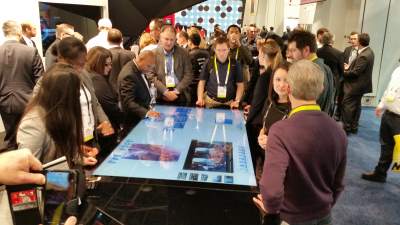 |
|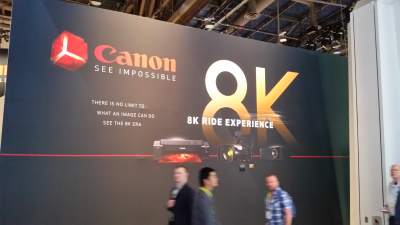 |
|Here’s a tablet that Hagrid could use! Actually, it’a high-resolution, multitouch display. I saw a couple of different manufacturers demo these. They were both beautiful, and performed just as you’d expect them to. I daredn’t ask the price of either of them, but if I had one, I’d gladly use it.|Now that you’ve purchased a high end HDR 8k TV, how do you go about feeding it native content? Simple, you get out your credit card again and buy one of these Canon cameras (and let me borrow it every now and then).|
|
|Here’s a tablet that Hagrid could use! Actually, it’a high-resolution, multitouch display. I saw a couple of different manufacturers demo these. They were both beautiful, and performed just as you’d expect them to. I daredn’t ask the price of either of them, but if I had one, I’d gladly use it.|Now that you’ve purchased a high end HDR 8k TV, how do you go about feeding it native content? Simple, you get out your credit card again and buy one of these Canon cameras (and let me borrow it every now and then).|
Now that you’ve purchased a high end HDR 8k TV, how do you go about feeding it native content? Simple, you get out your credit card again and buy one of these Canon cameras (and let me borrow it every now and then).
Sony had a similar booth to last year (same location, same geometry). The most impressive things they diplayed this year were their front projection TVs. In a section at the rear of their stand were mock-up rooms from a home of the future, and in each of these they were showing laser projectors onto walls.
Above you see a projection for a living room, against a blank wall. The projector (shown above right), lives in a small coffee table size box close the the wall. It’s wasn’t bad for a projection image, obviously not as good as a flat panel display, but pretty impressive from such a small projector, and one so close to the wall. There was no noticable ‘tombstone’ in the image and the image appeared uniform in brightness in the vertical plane. The whole image was brighter than expected.
| |
|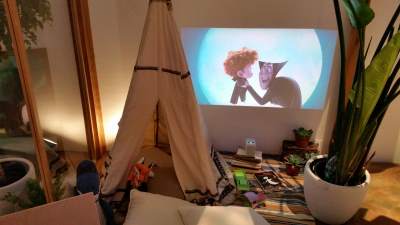 |
|Much smaller (portable) projectors were shown in other applications. Here you can see one in the master bedroom projecting a fireplace onto a wall. In this demo, it’s less compelling. It’s impossible to project black (black, after all is the absence of light), so in this fire place, where the logs are dark, you just see blank wall. I’m sure if the rest of the lights were down in the room in some romantic way, this would not be as much of an issue, but in this case, the lack of contrast resulted in a poor demo.|The final show case was the projection of a cartoon onto a childrens bedroom wall. The choice of the content loop here did not highlight the contrast issues described left, and the picture looked pretty good. The projector, again, was surprising small. You can see it as the ‘cube’ on the floor close to the wall below the picture.|
|
|Much smaller (portable) projectors were shown in other applications. Here you can see one in the master bedroom projecting a fireplace onto a wall. In this demo, it’s less compelling. It’s impossible to project black (black, after all is the absence of light), so in this fire place, where the logs are dark, you just see blank wall. I’m sure if the rest of the lights were down in the room in some romantic way, this would not be as much of an issue, but in this case, the lack of contrast resulted in a poor demo.|The final show case was the projection of a cartoon onto a childrens bedroom wall. The choice of the content loop here did not highlight the contrast issues described left, and the picture looked pretty good. The projector, again, was surprising small. You can see it as the ‘cube’ on the floor close to the wall below the picture.|
The final show case was the projection of a cartoon onto a childrens bedroom wall. The choice of the content loop here did not highlight the contrast issues described left, and the picture looked pretty good. The projector, again, was surprising small. You can see it as the ‘cube’ on the floor close to the wall below the picture.
Most impressive of all on the Sony stand, however, was the picture formed by a brace of VPL-VW5000ES laser projectors. These two (both projecting the same in parallel), produced a staggeringly beautiful picture on an entire wall. During the snow scenes, it was so bright you almost fealt like you should be wearing shades, it was as bright as being there in the sunlight! (As an experiment, I got the staff to temporarily cover part of the output of one of the projectors. The image dimmed noticable, but it still gave a nice picture. If you can afford one (I think they are about $50k each), then you can afford two, and the picture from two was just stunning.
In the foyer between the main halls was a Samsung gear VR setup where dozens of people at a time, in parallel, could get chance to experience the delights of VR. People seemed to love it. The queues for Oculus demos seemed to be about two hours long.
|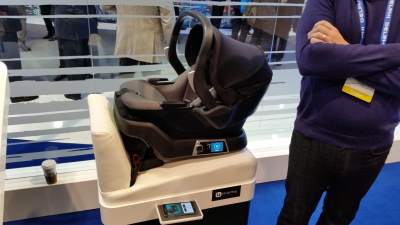 |In the auto section, I encountered another one of those, “huh?” products. It was a child car seat with built in technology. Not, it seems, to monitor the baby, but to tell you if it was installed correctly !?!?According to the person demoing the product, four out of five child car seats are not installed correctly. (He was not able to quote where that stat came from, or the consequneces of this), and he claimed this device solves that problem. It was not clear to me how (nor could he explain either) this device is better because in both a traditional car seat, and this device, the base of the car basinet is connected to the car using the LATCH system (so, there is not difference, and if 4/5 seats are installed incorrectly, surely this device will have the same odds of being installed incorrectly?)|
|In the auto section, I encountered another one of those, “huh?” products. It was a child car seat with built in technology. Not, it seems, to monitor the baby, but to tell you if it was installed correctly !?!?According to the person demoing the product, four out of five child car seats are not installed correctly. (He was not able to quote where that stat came from, or the consequneces of this), and he claimed this device solves that problem. It was not clear to me how (nor could he explain either) this device is better because in both a traditional car seat, and this device, the base of the car basinet is connected to the car using the LATCH system (so, there is not difference, and if 4/5 seats are installed incorrectly, surely this device will have the same odds of being installed incorrectly?)|
According to the person demoing the product, four out of five child car seats are not installed correctly. (He was not able to quote where that stat came from, or the consequneces of this), and he claimed this device solves that problem. It was not clear to me how (nor could he explain either) this device is better because in both a traditional car seat, and this device, the base of the car basinet is connected to the car using the LATCH system (so, there is not difference, and if 4/5 seats are installed incorrectly, surely this device will have the same odds of being installed incorrectly?)
In the car seats I used for my kids, you put in the upper basinet and it latched and clicked as you pushed it in; there really was no way to mess it up. In this design, you put the basinet on the base, and there was a whirr as some servo motor latched it for itself, then cheefully paged your phone to tell you that it was latched correctly, and (I kid you not), told you the status of the battery inside the seat that made the seat latch. If I put my child seat in the car, I’m right there, so I don’t need an app on my phone to be messaged that it’s been latched! And, I certainly don’t want an app that gives me functionality to remotely disengage the lock inadvertently (either from a app crash, or a butt-dial situation). Give me a physical interlock please for my kids’ safety.
If people really are installing child seats incorrrectly, I think education might be a better way to solve this problem than technology. (And it’s not clear how this product solves that installation problem anyway).
| |
| |
|Toyota where showing some whacky looking concept vehicles on the stand.|They also committed to spend a billion dollars (over the next five years) towards developing AI for self driving vehicles (working with places like Stanford and MIT).|
|
|Toyota where showing some whacky looking concept vehicles on the stand.|They also committed to spend a billion dollars (over the next five years) towards developing AI for self driving vehicles (working with places like Stanford and MIT).|
They also committed to spend a billion dollars (over the next five years) towards developing AI for self driving vehicles (working with places like Stanford and MIT).
At the Ford keynote, CEO Mark Fields commited to spending $4.5 billion on electric vehicle technology over the next four years, with a goal of bringing over a dozen new EV models to market by 2020. They plan to immediately triple their self-driving testing fleet.
Ford were showing some conventional internal combustion engine cars too. This yellow GT is an excpetionally beautiful car. It’s one of those cars where it is impossible to find a bad angle to take a photograph of. A Bugatti Veyron might be in a different universe when it comes to performance, and the pinnacle of what petrol driven vehicles can be, but it looks like a metallic cockroach compared to the car above.
The screen above right was mounted into the back of another demonstrator van and was showing what the sensors on the front of the van were detecting. You can see the green lidar sweeps, and the yellow bounding boxes were determining collisions issues (with so many people wandering around the front, it was impossible to take a good photo of it in use!)

I’ve mentioned it already, but cars really are becoming rolling super computers. The processing power that’s going to be installed in the next generation of automobiles to enable automated driving and driver assistance, will make today’s game console makers envious.
| |Here’s a VW product. On the VW booth, I caught mention of “Bidirectional Charging”. This is not the ability to charge a battery when running in reverse! It’s a concept of using the large batteries in your vehicle as a capacitor, incase the electric grid temporary loses supply.You come home everyday, and plug in your car to top it up off the grid. However, if there is a power outage and grid supply is not available, your house is able to feed off the residual power in your car to keep your fridge running, and your TV on!|
|Here’s a VW product. On the VW booth, I caught mention of “Bidirectional Charging”. This is not the ability to charge a battery when running in reverse! It’s a concept of using the large batteries in your vehicle as a capacitor, incase the electric grid temporary loses supply.You come home everyday, and plug in your car to top it up off the grid. However, if there is a power outage and grid supply is not available, your house is able to feed off the residual power in your car to keep your fridge running, and your TV on!|
You come home everyday, and plug in your car to top it up off the grid. However, if there is a power outage and grid supply is not available, your house is able to feed off the residual power in your car to keep your fridge running, and your TV on!
Audi were showing off lots of technology demonstrators and concepts too.
| |The show was not just about conceptsHere is a picture of the Chevy Bolt EV. I have to say it’s a pretty nice looking vehicle. Even the wheel rims are nice! It will retail for approx. $30,000 and have a range of about 200 miles, according to the keynote from GM’s CEO, Mary Barra, as she gave her keynote broadcast live over Facebook Live (Yeah!); the first automaker to use the product for a live press release.In additional to being electrically driven, it’s bristling with technology internally for the driver and passengers with Apple CarPlay and Android Auto connectivity (yet again, no Microsoft. Wake up Redmond; it’s all going to be happening in the next few years, and you are getting left behind).|
|The show was not just about conceptsHere is a picture of the Chevy Bolt EV. I have to say it’s a pretty nice looking vehicle. Even the wheel rims are nice! It will retail for approx. $30,000 and have a range of about 200 miles, according to the keynote from GM’s CEO, Mary Barra, as she gave her keynote broadcast live over Facebook Live (Yeah!); the first automaker to use the product for a live press release.In additional to being electrically driven, it’s bristling with technology internally for the driver and passengers with Apple CarPlay and Android Auto connectivity (yet again, no Microsoft. Wake up Redmond; it’s all going to be happening in the next few years, and you are getting left behind).|
Here is a picture of the Chevy Bolt EV. I have to say it’s a pretty nice looking vehicle. Even the wheel rims are nice! It will retail for approx. $30,000 and have a range of about 200 miles, according to the keynote from GM’s CEO, Mary Barra, as she gave her keynote broadcast live over Facebook Live (Yeah!); the first automaker to use the product for a live press release.
|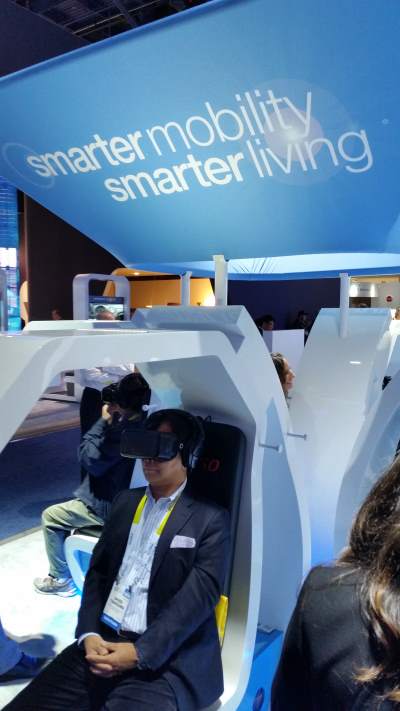 |
|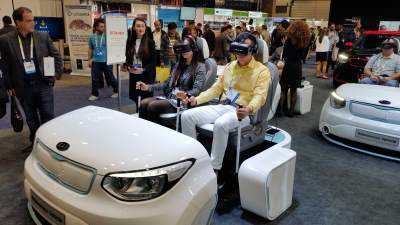 I wasn’t sure quite what to make of this. We’re getting more automation, and cars are going to drive themselves, so here’s a VR simulation of what it will be like when the computer does this. Oh well, great use of technology either way!There wasn’t just one company doing it, lots of people were.VR really does give you a chance to experience the future. It’s like a personal time machine (and teleporter). It’s not just for games!|
I wasn’t sure quite what to make of this. We’re getting more automation, and cars are going to drive themselves, so here’s a VR simulation of what it will be like when the computer does this. Oh well, great use of technology either way!There wasn’t just one company doing it, lots of people were.VR really does give you a chance to experience the future. It’s like a personal time machine (and teleporter). It’s not just for games!|
I wasn’t sure quite what to make of this. We’re getting more automation, and cars are going to drive themselves, so here’s a VR simulation of what it will be like when the computer does this. Oh well, great use of technology either way!
VR really does give you a chance to experience the future. It’s like a personal time machine (and teleporter). It’s not just for games!
What would happen if a bicycle made love to a pram and had a child?
Something like this? (Don’t ask me what it was doing at CES!)
This Mercedes concept looks aerodynamically mixed; It’s missing mirrors and door handles to give it a smooth profile, but the wheels are not shrouded, and the back falls away too fast. I’m guessing they wanted to keep it having a recognizable profile - without this, if all cars were designed optimally in wind tunnels, they’d all end up with the same tear-drop shape.
According the Mercedes, the three reasons why now is the time that we’re getting smart technology in cars are: Big Data, Computer Speed, and Better Algorithms. So now you know :)
| |
|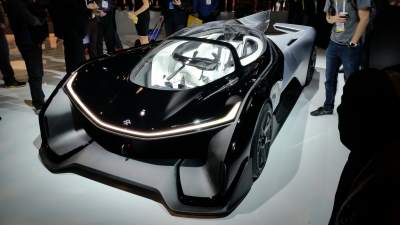 |
|Nice car. (It’s the most powerful and lightest model in the McLaren Super Series). According to McLaren, it boasts 666bhp (from a V8 twin turbo), a top speed of 205 mph, and a sub 3 second 0-60mph acceleration potential.|If Batman were going to own an electric car, this might be what he would drive. This is the FFZERO1, the Faraday Future concept vehicle. It’s a single seat, quad motor (1000 bhp?) car, also with a projected top speed in excess of 200 mph, and 0-60 acceleration sub 3 seconds.|
|
|Nice car. (It’s the most powerful and lightest model in the McLaren Super Series). According to McLaren, it boasts 666bhp (from a V8 twin turbo), a top speed of 205 mph, and a sub 3 second 0-60mph acceleration potential.|If Batman were going to own an electric car, this might be what he would drive. This is the FFZERO1, the Faraday Future concept vehicle. It’s a single seat, quad motor (1000 bhp?) car, also with a projected top speed in excess of 200 mph, and 0-60 acceleration sub 3 seconds.|
If Batman were going to own an electric car, this might be what he would drive. This is the FFZERO1, the Faraday Future concept vehicle. It’s a single seat, quad motor (1000 bhp?) car, also with a projected top speed in excess of 200 mph, and 0-60 acceleration sub 3 seconds.
Electric or combustion engine, both are feats of engineering excellence capable of travelling at speeds in excess of three miles a minute.
| |I don’t have a smartwatch, but if I did, I’d buy one of these.It’s a combined, integrated phone stand charger and smartwatch stand and charger.As smartwatches need charging, religiously, everynight, this device could be part of your everyday routine. With this device on your bedside table, as you take off your watch for bed, you could hang it here next to your phone and have everything ready for the next morning.Until, of course, you go on a business trip, and realize you’ve left the charging stand to home …This particular product, from Belkin, won a 2016 innovation award from CES.|
|I don’t have a smartwatch, but if I did, I’d buy one of these.It’s a combined, integrated phone stand charger and smartwatch stand and charger.As smartwatches need charging, religiously, everynight, this device could be part of your everyday routine. With this device on your bedside table, as you take off your watch for bed, you could hang it here next to your phone and have everything ready for the next morning.Until, of course, you go on a business trip, and realize you’ve left the charging stand to home …This particular product, from Belkin, won a 2016 innovation award from CES.|
It’s a combined, integrated phone stand charger and smartwatch stand and charger.
Until, of course, you go on a business trip, and realize you’ve left the charging stand to home …
| |This was a nice item to see. It was actually just in the convention center, not directly on the show floor, but it was a complimentary phone charging station.The cabinet had a collection of small cubicles into which you could install your phone, protected by a digital lock (like the ones on hotel safe boxes). You could put in your phone, lock it up for twenty minutes so that it could get a good boost whilst you went off for a coffee/bathroom break. Much safer (and much more convenient), than searching around for a wall socket, plugging in a wall-wart charger you had to carry, then sitting or loitering around in the corridor waiting for things to charge.Considering the convenience, utility, and safety this product provides, I’d have no problem paying a nominal charge for the service if I found one out in the wild and had a need.However, at the show, plenty of other booths were, nicely, providing ‘charging stations’, with little shelves and adaptor leads for show goers to stop by and use. (Thanks to all who did this). I stopped by a couple of them for a few minutes each to pull a couple of percentage bars back. It wasn’t quite the same utility as the locked cabinet, as I had to stand guard, but it was still greatly appreciated.Internet road warriors know there is nothing worse that low bars on your battery gauges.|
|This was a nice item to see. It was actually just in the convention center, not directly on the show floor, but it was a complimentary phone charging station.The cabinet had a collection of small cubicles into which you could install your phone, protected by a digital lock (like the ones on hotel safe boxes). You could put in your phone, lock it up for twenty minutes so that it could get a good boost whilst you went off for a coffee/bathroom break. Much safer (and much more convenient), than searching around for a wall socket, plugging in a wall-wart charger you had to carry, then sitting or loitering around in the corridor waiting for things to charge.Considering the convenience, utility, and safety this product provides, I’d have no problem paying a nominal charge for the service if I found one out in the wild and had a need.However, at the show, plenty of other booths were, nicely, providing ‘charging stations’, with little shelves and adaptor leads for show goers to stop by and use. (Thanks to all who did this). I stopped by a couple of them for a few minutes each to pull a couple of percentage bars back. It wasn’t quite the same utility as the locked cabinet, as I had to stand guard, but it was still greatly appreciated.Internet road warriors know there is nothing worse that low bars on your battery gauges.|
The cabinet had a collection of small cubicles into which you could install your phone, protected by a digital lock (like the ones on hotel safe boxes). You could put in your phone, lock it up for twenty minutes so that it could get a good boost whilst you went off for a coffee/bathroom break. Much safer (and much more convenient), than searching around for a wall socket, plugging in a wall-wart charger you had to carry, then sitting or loitering around in the corridor waiting for things to charge.
However, at the show, plenty of other booths were, nicely, providing ‘charging stations’, with little shelves and adaptor leads for show goers to stop by and use. (Thanks to all who did this). I stopped by a couple of them for a few minutes each to pull a couple of percentage bars back. It wasn’t quite the same utility as the locked cabinet, as I had to stand guard, but it was still greatly appreciated.
| |
| |
|These suits were not augmentation suits to give people super-human strength. Instead they added resistance to mimic the effect of what happens to people with various levels of disability. By applying resistance, or range of movement, to certain joints (to mimic arthritis or injury), the effects on the body and how it compensates can be determined, and this data used to provide people with better products.|Want to run a competition for geeks at a show? How about a challenge to see how many marshmallows it’s possible to stuff into your mouth and still get Siri to recongnize and respond correctly to verbal requests.|
|
|These suits were not augmentation suits to give people super-human strength. Instead they added resistance to mimic the effect of what happens to people with various levels of disability. By applying resistance, or range of movement, to certain joints (to mimic arthritis or injury), the effects on the body and how it compensates can be determined, and this data used to provide people with better products.|Want to run a competition for geeks at a show? How about a challenge to see how many marshmallows it’s possible to stuff into your mouth and still get Siri to recongnize and respond correctly to verbal requests.|
Want to run a competition for geeks at a show? How about a challenge to see how many marshmallows it’s possible to stuff into your mouth and still get Siri to recongnize and respond correctly to verbal requests.
| |
|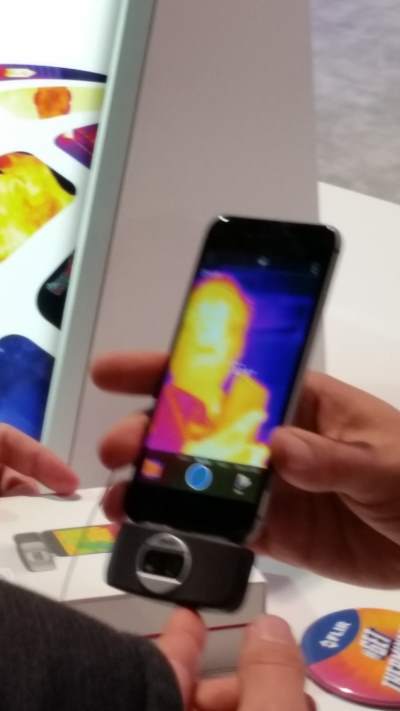 |
|Not as many telepresensce robots were on display this year as last year (maybe VR is going replace the need for these?) This company compenstated by driving around a Hagrid sized one.|I don’t really have a need for one of these, but I wish I did as they’d be fun to play with. They are small modules you can plug into your phone to give it an infra-red camera (sensitive to heat). FLIR also had modules you could place on drones to aerially search for heat loss, hot spots, or fires. Neat stuff.|
|
|Not as many telepresensce robots were on display this year as last year (maybe VR is going replace the need for these?) This company compenstated by driving around a Hagrid sized one.|I don’t really have a need for one of these, but I wish I did as they’d be fun to play with. They are small modules you can plug into your phone to give it an infra-red camera (sensitive to heat). FLIR also had modules you could place on drones to aerially search for heat loss, hot spots, or fires. Neat stuff.|
I don’t really have a need for one of these, but I wish I did as they’d be fun to play with. They are small modules you can plug into your phone to give it an infra-red camera (sensitive to heat). FLIR also had modules you could place on drones to aerially search for heat loss, hot spots, or fires. Neat stuff.
| |
| |
|As mentioned earlier, there were dozens and dozens of drone companies flying their toys around. It wasn’t just the drones themselves, there were people demonstrating sophisticated ground and control setups. Check out these folks who arrived with a van kitted out with more high-tech surveillance gear than a Hollywood movie.|And remember folks, if you are in the US, you need to register your drone. The FAA has not forgotten and had a booth here to explain things and remind people to: Fly Smart, Fly Safe, and Have Fun.|
|
|As mentioned earlier, there were dozens and dozens of drone companies flying their toys around. It wasn’t just the drones themselves, there were people demonstrating sophisticated ground and control setups. Check out these folks who arrived with a van kitted out with more high-tech surveillance gear than a Hollywood movie.|And remember folks, if you are in the US, you need to register your drone. The FAA has not forgotten and had a booth here to explain things and remind people to: Fly Smart, Fly Safe, and Have Fun.|
And remember folks, if you are in the US, you need to register your drone. The FAA has not forgotten and had a booth here to explain things and remind people to: Fly Smart, Fly Safe, and Have Fun.
| |
| |
|Drones of all sizes were on display, from ones that would fit in the palm of your hand to ones cables of holding full sized DSLR cameras. There were drones with 4, 6, 8 (and more) rotors, and ones with propellers both above and below the frame.This particular one (a French design) was a damage tolerant one. A ‘traditional’ drone was installed inside a geodeisic sphere. This thing could roll along the floor, up walls, through trees and branches, as well as fly. There was an interesting demo video of it passing through a warehouse/shop floor, over machines, up fire escapes, over railings, flying, and passing up walls. Part of the time rolling, part flying, and part bouncing off things in its path!|It was not just flying drones. Here was a drone submarine (though it needed an umbilical cable).
|
|Drones of all sizes were on display, from ones that would fit in the palm of your hand to ones cables of holding full sized DSLR cameras. There were drones with 4, 6, 8 (and more) rotors, and ones with propellers both above and below the frame.This particular one (a French design) was a damage tolerant one. A ‘traditional’ drone was installed inside a geodeisic sphere. This thing could roll along the floor, up walls, through trees and branches, as well as fly. There was an interesting demo video of it passing through a warehouse/shop floor, over machines, up fire escapes, over railings, flying, and passing up walls. Part of the time rolling, part flying, and part bouncing off things in its path!|It was not just flying drones. Here was a drone submarine (though it needed an umbilical cable). |
|
This particular one (a French design) was a damage tolerant one. A ‘traditional’ drone was installed inside a geodeisic sphere. This thing could roll along the floor, up walls, through trees and branches, as well as fly. There was an interesting demo video of it passing through a warehouse/shop floor, over machines, up fire escapes, over railings, flying, and passing up walls. Part of the time rolling, part flying, and part bouncing off things in its path!
Peripherals to augment VR devices where one display (not as many guns as last year). Two different technologies to allow people to run wearing the headset were on display. One, in which you wore slippery shoes, and ran in curved dish (shown left), and one, a more sophisticated prototype, which consisted of two independantly moving axes of belts that allowed unrestricted movment in an direction on the plane.
| |
| |
|These kids shoes had games built into them|There were quite a lot of glasses that had various levels of augmentation built in. The ones I had chance to try did not attempt to do any positional tracking, nor pupil tracking so just allowed a semi-transparent video overlay, collimated, to be displayed in my field of view.|
|
|These kids shoes had games built into them|There were quite a lot of glasses that had various levels of augmentation built in. The ones I had chance to try did not attempt to do any positional tracking, nor pupil tracking so just allowed a semi-transparent video overlay, collimated, to be displayed in my field of view.|
There were quite a lot of glasses that had various levels of augmentation built in. The ones I had chance to try did not attempt to do any positional tracking, nor pupil tracking so just allowed a semi-transparent video overlay, collimated, to be displayed in my field of view.
| |More goggles.|
|More goggles.|
This is pretty small sensor. James Bond’s “Q” would be proud.

Do you miss your pet when you are at work? How about installing a ‘doggyphone’ on the wall of your house so you can call him/her from work? Is your pet smart? If so you can train it to push a call button so that it can call you when it is lonely for a video chat. Do you like to spoil your pet? With the push of a button you can remotely drop it a doggy treat (or cat treat, I guess).
What goes well with VR goggles? 360 video of course. How do you record 360 video, well one way is with a rig like this of comprised of high end DSLR cameras.
Other, much smaller, proprietery devices were on display too, such as the Vuze. (I didn’t get chance to see it, but Nikon also launched a 360° ruggedized camera too).
|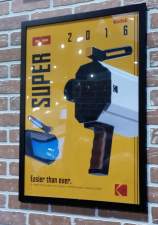 |OK, I’m still waiting for someone to finally confess. This is a joke, right?I mean, are you serious?Kodak is releasing a new Super 8 Camera. A revival. It looks similar to an old Super 8 camera, except that it also has a digital view finder on a flip-out screen (like a camcorder).It still uses a reel of (expensive) film in a cartridge, then you’ll then have to send off to a film processor (expensive again; expected to be about $50 for the few minutes possible on each reel), who will then develop it and then digitize the final film and send you the diigtal copy (I’m guessing you can also pay to have the exposed film returned too).I’m sorry, I don’t get it.|
|OK, I’m still waiting for someone to finally confess. This is a joke, right?I mean, are you serious?Kodak is releasing a new Super 8 Camera. A revival. It looks similar to an old Super 8 camera, except that it also has a digital view finder on a flip-out screen (like a camcorder).It still uses a reel of (expensive) film in a cartridge, then you’ll then have to send off to a film processor (expensive again; expected to be about $50 for the few minutes possible on each reel), who will then develop it and then digitize the final film and send you the diigtal copy (I’m guessing you can also pay to have the exposed film returned too).I’m sorry, I don’t get it.|
I mean, are you serious?
It still uses a reel of (expensive) film in a cartridge, then you’ll then have to send off to a film processor (expensive again; expected to be about $50 for the few minutes possible on each reel), who will then develop it and then digitize the final film and send you the diigtal copy (I’m guessing you can also pay to have the exposed film returned too).
| |
| |
|Here’s a neat little device (albeit niche use). It’s a solar powered time-lapse camera. Take it to where you want it, then just leave it. It will power up, on schedule, take pics, and compile them to a movie (and transmit them wirelessly, if desired).|Here’s the world’s first smart vibrator designed to be driven by erotic books. It includes a free reading app for iOS and Android (sorry Windows Phone users), and a content creation platform for authors. [No comment].|
|
|Here’s a neat little device (albeit niche use). It’s a solar powered time-lapse camera. Take it to where you want it, then just leave it. It will power up, on schedule, take pics, and compile them to a movie (and transmit them wirelessly, if desired).|Here’s the world’s first smart vibrator designed to be driven by erotic books. It includes a free reading app for iOS and Android (sorry Windows Phone users), and a content creation platform for authors. [No comment].|
Here’s the world’s first smart vibrator designed to be driven by erotic books. It includes a free reading app for iOS and Android (sorry Windows Phone users), and a content creation platform for authors. [No comment].
On my second day at the show, I spent time in the innovation halls. These were bristling with lots of little booths. Some of the products were novel, some were crazy. Here is a small collection of things I saw:
Whilst not staggeringly new, lots of people were showing “whirlygigs” (spinning LEDs that were pulsed to draw pictures formed by the persistence of vision in the eye/brain).
| |
| |
|Some were built into fans …|… some larger and spining to give the appearance of psuedo-3D.|
|
|Some were built into fans …|… some larger and spining to give the appearance of psuedo-3D.|
… some larger and spining to give the appearance of psuedo-3D.
| |
| |
|This was a novel little item; it was a small array of colored LEDs that you could plug into an outlet and it would flicker and create ambient lighting in a room that emulated a TV. If you are leaving the house and want to give the impression it is still occupied, you could pull down the blinds, and plug this in. At night, from outside, it would look like someone was enjoying TV. (It reminded me of an article I read recently on Hacker News about reverse engineering a candle flicker).|Here were some smartphone backs filled with a fluid and glitter (sort of like a cross between an egg-timer and lava lamp), as you moved your phone around, they made pretty patterns.|
|
|This was a novel little item; it was a small array of colored LEDs that you could plug into an outlet and it would flicker and create ambient lighting in a room that emulated a TV. If you are leaving the house and want to give the impression it is still occupied, you could pull down the blinds, and plug this in. At night, from outside, it would look like someone was enjoying TV. (It reminded me of an article I read recently on Hacker News about reverse engineering a candle flicker).|Here were some smartphone backs filled with a fluid and glitter (sort of like a cross between an egg-timer and lava lamp), as you moved your phone around, they made pretty patterns.|
Here were some smartphone backs filled with a fluid and glitter (sort of like a cross between an egg-timer and lava lamp), as you moved your phone around, they made pretty patterns.
| |
| |
|These guys were working on modules that could be connected together to make a tactile display as a dynamic screen for blind users.|Addressable dots could be pushed out of the display to render braile characters, or graphics.|
|
|These guys were working on modules that could be connected together to make a tactile display as a dynamic screen for blind users.|Addressable dots could be pushed out of the display to render braile characters, or graphics.|
Addressable dots could be pushed out of the display to render braile characters, or graphics.
| |
| |
|Here’s a tracker placed in a lighter, that both helps you and ‘helps’ you. If you need a cigarette, it will enable you to light it, but then it keeps track of your consumption to help you to quit.|I lost track (see what I did there?) of the number of pet activity monitors there were on display. Put a fitbit on yourself, and a collar on your pooch. Then, from the luxury of your desk at work you can see how active your pet has been during the day. (Others were using these as ‘kid trackers’, both to monitor your kids’ activities and also as security devices to retreive lost children).|
|
|Here’s a tracker placed in a lighter, that both helps you and ‘helps’ you. If you need a cigarette, it will enable you to light it, but then it keeps track of your consumption to help you to quit.|I lost track (see what I did there?) of the number of pet activity monitors there were on display. Put a fitbit on yourself, and a collar on your pooch. Then, from the luxury of your desk at work you can see how active your pet has been during the day. (Others were using these as ‘kid trackers’, both to monitor your kids’ activities and also as security devices to retreive lost children).|
I lost track (see what I did there?) of the number of pet activity monitors there were on display. Put a fitbit on yourself, and a collar on your pooch. Then, from the luxury of your desk at work you can see how active your pet has been during the day. (Others were using these as ‘kid trackers’, both to monitor your kids’ activities and also as security devices to retreive lost children).
| |
| |
|Are you an active person? If so, strap this box to a limb and go exercise. It claims to be able to generate enough energy to power a phone for five hours for every one hour of vigorous exercise. (Better yet, do you have a dog? …)|Are you environmentally concious? Plug this plug into an outlet, then daisy chain your downstream plug into this. It has a green LED, and listens to the cloud. When it detects you are using power that has been ‘sourced’ from a sustainable source, it turns green (I guess so that you can feel smug that you’re using power that, at that time, is not contributing to worsening things). It’s a strange concept because you’re not actually buying power from this green source; you are still paying your normal electricity bill with your existing provider. To me, this is the workings of a good idea, but it needs to be taken further. Why not put a relay in there and allow it be turned on/off? Maybe I have some non-essential items in my house e.g.a fountain, or vanity light. If there is green energy available on the grid, these devices can run, if not, shut them off. |
|
|Are you an active person? If so, strap this box to a limb and go exercise. It claims to be able to generate enough energy to power a phone for five hours for every one hour of vigorous exercise. (Better yet, do you have a dog? …)|Are you environmentally concious? Plug this plug into an outlet, then daisy chain your downstream plug into this. It has a green LED, and listens to the cloud. When it detects you are using power that has been ‘sourced’ from a sustainable source, it turns green (I guess so that you can feel smug that you’re using power that, at that time, is not contributing to worsening things). It’s a strange concept because you’re not actually buying power from this green source; you are still paying your normal electricity bill with your existing provider. To me, this is the workings of a good idea, but it needs to be taken further. Why not put a relay in there and allow it be turned on/off? Maybe I have some non-essential items in my house e.g.a fountain, or vanity light. If there is green energy available on the grid, these devices can run, if not, shut them off. |
Are you environmentally concious? Plug this plug into an outlet, then daisy chain your downstream plug into this. It has a green LED, and listens to the cloud. When it detects you are using power that has been ‘sourced’ from a sustainable source, it turns green (I guess so that you can feel smug that you’re using power that, at that time, is not contributing to worsening things). It’s a strange concept because you’re not actually buying power from this green source; you are still paying your normal electricity bill with your existing provider. To me, this is the workings of a good idea, but it needs to be taken further. Why not put a relay in there and allow it be turned on/off? Maybe I have some non-essential items in my house e.g.a fountain, or vanity light. If there is green energy available on the grid, these devices can run, if not, shut them off.
|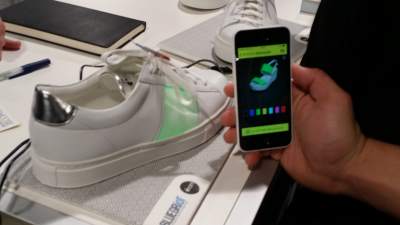 |
| |
|How about a shoe with light panels you can control via an app?|Or a programmatically polarising sun shade for your car?|
|
|How about a shoe with light panels you can control via an app?|Or a programmatically polarising sun shade for your car?|
Or a programmatically polarising sun shade for your car?
| |How many times a month do you have to reset your router?How many times a month do you get a phone call from your kids “Dad, the internet isn’t working”?Certainly, with my provider, these situations happen more frequently than they should, and typically a power on/off reset cycle is all that is needed to resolve the sitation. This reset plug (into which you should plug your modem/router) monitors an external location over WiFi. After a while, if this location is not accesible, it cycles the power, and hopefully resolves the problem.If you are on the hook for providing support for a technically iliterate relative, or have a remote computing device providing some service, this might be a product you should investigate.|
|How many times a month do you have to reset your router?How many times a month do you get a phone call from your kids “Dad, the internet isn’t working”?Certainly, with my provider, these situations happen more frequently than they should, and typically a power on/off reset cycle is all that is needed to resolve the sitation. This reset plug (into which you should plug your modem/router) monitors an external location over WiFi. After a while, if this location is not accesible, it cycles the power, and hopefully resolves the problem.If you are on the hook for providing support for a technically iliterate relative, or have a remote computing device providing some service, this might be a product you should investigate.|
How many times a month do you get a phone call from your kids “Dad, the internet isn’t working”?
If you are on the hook for providing support for a technically iliterate relative, or have a remote computing device providing some service, this might be a product you should investigate.
| |Ever wondered what 100 Raspberry Pi 2 would look like connected together in a perspex box?Wonder no longer!It’s certainly a work of art, and I’m geeking out looking at it, but considering how cheap elastic computing resources can be rented from people like Amazon, I can’t really see that, even something as cheap as this, would every repay back the investment made considering the performance you can rent online.If you need performance these days in bursts, then it’s better to borrow than build. If you need performance continuously, I don’t think you’d be looking at a solution like this.Raspberry Pis are great, but this is not their best use.|
|Ever wondered what 100 Raspberry Pi 2 would look like connected together in a perspex box?Wonder no longer!It’s certainly a work of art, and I’m geeking out looking at it, but considering how cheap elastic computing resources can be rented from people like Amazon, I can’t really see that, even something as cheap as this, would every repay back the investment made considering the performance you can rent online.If you need performance these days in bursts, then it’s better to borrow than build. If you need performance continuously, I don’t think you’d be looking at a solution like this.Raspberry Pis are great, but this is not their best use.|
Wonder no longer!
If you need performance these days in bursts, then it’s better to borrow than build. If you need performance continuously, I don’t think you’d be looking at a solution like this.
Selling a dream? A clothes folding robot.
This booth was happy to remind us how much time we’d save a year if we had a clothes folding robot, and displayed what looked like a cabinet into which neatly folded clothes were stacked with some ‘black box’ above that was magically washing, drying, and folding these clothes, and stacking them neatly on the shelves below.
Absent, however, was any kind of demo, anything working, or even a rough outline of what it was actually doing (and how it was doing it).
OK, onto more things that really don’t need to be IoT …
| |
| Why on Earth would anyone need an internet connected frying pan? I can’t think of a really good scenario when this would add value.However, that pales into insignificance when compared to an internet spatula !?!?! What does it do? record the number of times I’ve flipped my pancakes, or a spoon that can tell my how many times I’ve spooned my batter?(Out of all the connected kitchen devices on the table, the only one I can see value in is the probe thermometer. Having a digital broadcast of temperature and using this to control an oven will enable perfect cooking of meat and baked goods).|
Why on Earth would anyone need an internet connected frying pan? I can’t think of a really good scenario when this would add value.However, that pales into insignificance when compared to an internet spatula !?!?! What does it do? record the number of times I’ve flipped my pancakes, or a spoon that can tell my how many times I’ve spooned my batter?(Out of all the connected kitchen devices on the table, the only one I can see value in is the probe thermometer. Having a digital broadcast of temperature and using this to control an oven will enable perfect cooking of meat and baked goods).|
However, that pales into insignificance when compared to an internet spatula !?!?! What does it do? record the number of times I’ve flipped my pancakes, or a spoon that can tell my how many times I’ve spooned my batter?
| |Even Girl Scout cookies are going 21st Century.Pretty soon you’ll be ordering them online, and paying with your credit card.(A representative from the association, however, informed me that cookies would still be delivered in person, and not by drone).|
|Even Girl Scout cookies are going 21st Century.Pretty soon you’ll be ordering them online, and paying with your credit card.(A representative from the association, however, informed me that cookies would still be delivered in person, and not by drone).|
Pretty soon you’ll be ordering them online, and paying with your credit card.
| |
| |
|Does your cat like to chase laser pointers? Do you get bored before it does? Do you wish you could entertain your cat remotely? Then this is the device for you! Integrating a laser pointer and servo motors you can produce swirling paths of dots for your cat to chase. Remotely turn it on into random mode using a handy app, and give your cat entertainment. Want to feel involved? Use the app the move the pointer yourself!|What do you do when your hands are busy and still need to control something? Why, you should smile at it. OK, joking aside, this technology has potentially great benefit for disabled people. I wish them every success.|
|
|Does your cat like to chase laser pointers? Do you get bored before it does? Do you wish you could entertain your cat remotely? Then this is the device for you! Integrating a laser pointer and servo motors you can produce swirling paths of dots for your cat to chase. Remotely turn it on into random mode using a handy app, and give your cat entertainment. Want to feel involved? Use the app the move the pointer yourself!|What do you do when your hands are busy and still need to control something? Why, you should smile at it. OK, joking aside, this technology has potentially great benefit for disabled people. I wish them every success.|
What do you do when your hands are busy and still need to control something? Why, you should smile at it. OK, joking aside, this technology has potentially great benefit for disabled people. I wish them every success.
| |Here’s a neat little product (in the shape of a cube that can double as a keychain), that has eight additional functions:- Integrated Flash Drive- Fast Charger- Phone Stand- Built in adpator cable- Built in Micro-SD reader- LED torch- Sync- Emergency Charger|
|Here’s a neat little product (in the shape of a cube that can double as a keychain), that has eight additional functions:- Integrated Flash Drive- Fast Charger- Phone Stand- Built in adpator cable- Built in Micro-SD reader- LED torch- Sync- Emergency Charger|
The product won a CES 2016 Innovation award.
| |
| |
|Real time radiation monitoring equipment.|As seen on SharkTank, a phone/tablet sanetizer system that uses strong UV light.|
|
|Real time radiation monitoring equipment.|As seen on SharkTank, a phone/tablet sanetizer system that uses strong UV light.|
As seen on SharkTank, a phone/tablet sanetizer system that uses strong UV light.
Proof of how fast Moore’s Law can make what was, a dozen years ago, now trivially possible. A complete Arduino driven gaming system in the size of a credit card!

 |
 |
| The easiest job at CES? Staying in bed all day reading books and demonstrating this iPad bed stand? | I really liked the idea of this clock which, at a glance, could show you what to expect over a day. Sort of like a day-view in outlook, with different colors used for meetings and other scheduled events. (Because a clock face, however, works over 12 hours, it’s not clear how well it would show/indicate events before and after midday). |
I really liked the idea of this clock which, at a glance, could show you what to expect over a day. Sort of like a day-view in outlook, with different colors used for meetings and other scheduled events. (Because a clock face, however, works over 12 hours, it’s not clear how well it would show/indicate events before and after midday).
No, just no.

Electric scooters, ‘hover boards’, segway like devices of all sizes were being driven around.
|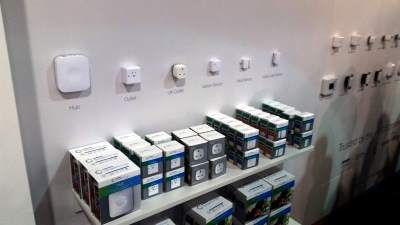 |Because I ran out of time, this was the section of the show that I elected to breeze through. Companies were showing every possible kind of connected switch, plug, socket, detector, burglar alarm, smoke detector, lighting controller, door locks, and sprinkler control systems.Various standards, compatibility bridges, controllers seemed to be displayed. I did not get chance to deep dive into any of them. My impression about these things, however, remains that the devil is going to be in the set-up, configuration, and programming. Hardware is one thing, but getting this to behave how you want it to is a lot harder. |
|Because I ran out of time, this was the section of the show that I elected to breeze through. Companies were showing every possible kind of connected switch, plug, socket, detector, burglar alarm, smoke detector, lighting controller, door locks, and sprinkler control systems.Various standards, compatibility bridges, controllers seemed to be displayed. I did not get chance to deep dive into any of them. My impression about these things, however, remains that the devil is going to be in the set-up, configuration, and programming. Hardware is one thing, but getting this to behave how you want it to is a lot harder. |
Various standards, compatibility bridges, controllers seemed to be displayed. I did not get chance to deep dive into any of them. My impression about these things, however, remains that the devil is going to be in the set-up, configuration, and programming. Hardware is one thing, but getting this to behave how you want it to is a lot harder.

Gamification of health and fitness was everywhere.

As mentioned earlier, every kind of fitness band was on display. Technology is migrating to fitness shoes, and even fitness sensing clothing and ‘posture trainers’.
Sleep sensors were popular too, either using the fitness bands you were already wearing, or dedicated sensors placed under/on your bed.
Want to get better at basketball? Why not track where your shots are being shot from, and which ones are more successfull than others.
In addition to the fitness bands there were also connected toothbrushes, pet trackers, sleep trackers and fertility mointors (and the ever popular connected scales that measure percentage of body fat). There were even stuffed toys that could be used to ‘remotely’ hug people on display (and ‘smart pillows’). I saw an alarm clock that would wake you up with aromas (I’m sure ‘burning house’ was not one of the smells).
A couple of stands were showing smart pill bottles that chimed when it was ready to take your medication. I can see this as value if you carry your pill bottle with you on person at all times, and thus will be there to hear it when it chimes, but wouldn’t it be better to have this reminder app on your phone/watch, which you do have on you at all times, and this is what chimes until it gets next to the bottle and confirms you have taken it?
3D printing is now a well established and a fairly mature product line. Printers are getting faster, more accurate, larger, and the materials they can print from are increasing in sophistication. I saw printers printing flexible, and rigid. I even saw (and tasted), 3D printed food (a very tasty passion fruit hyper-cube cookie). There were even 3D printed shoes and clothes. Here are a couple of random pictures of some of the models I saw printed:
The most dangerous looking device seen at the show was not a self-driving car (in which I’d probably feel pretty safe). It was this monster drone. Making a fair amount of noise, periodically, this thing would lift up from the ground to show it hoisting a 50lb weight.

Thankfully the drone was performing behind a thick plexiglass case, and was constrained to move vertically by sliding on poles.
In the category of things that I will least likely to be able to install in my house was this multi-axis simulator.
An Oculus headseat will allow one to see what it’s like to by ascending a slope at 60° to the vertical; a device like this will allow the visual experience to be augmented with the physical forces too.
Having spent a fair amount of time around professional flight simulator equipment, I can say that this device moved positively pedestrian. Maybe it’s just a prototype, or they were dialing it down for the victims inside (I never bothered to ask), but the slew rate was just a couple of degrees a second. I counted to ten and and it had not made a quarter turn! I think I might have fallen asleep before it had made one revolution.
In the 2016 Innovation awards was shown the Mattel View-Master.

I remember receiving my first View-Master almost 40 years ago as a present from my parents after their first visit to America. It allowed me to see what Disneyland was like in 3D. For over 75 years, a couple of generations of kids have experienced snap-shots of the world using stereoscopic static images. This device (a clam-shell for a mobile device), moves the product into the next century. It looks like it will fit nicely in the VR spectrum of offerings between Google Cardboard and Samsung Gear VR.
VR really is a teleporter and time machine combined.
You can find a complete list of all the articles here. Click here to receive email alerts on new articles.
Click here to receive email alerts on new articles.